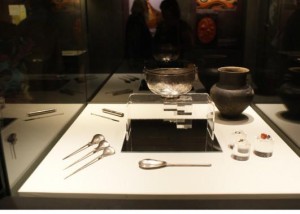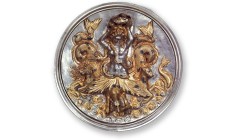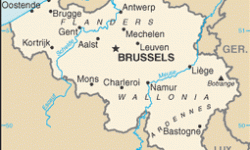Everbeek Roman Silver Hoard
Author: Pieterjan Deckers
Last Modified: 26 Dec 2012
Also known as: Silver Hoard of Everbeek, & Zilverschat van Everbeek

The third-century Roman silver hoard from Everbeek is one of the most high-profile archaeological finds of recent years in Flanders and it has contributed to the political debate surrounding amateur metal detection.
Its high profile is due not only to its scientific and financial value, but also to the circumstances of its discovery and curation. Despite apparently being the result of illegal excavation by a metal-detector user, and remaining unreported for at least two years, it was acquired by the Provincial Archaeological Museum at Velzeke.
Discovery
In December 2010, the Provincial Archaeological Museum in Velzeke announced that it had acquired a Roman hoard of silver artefacts – a unique find in Belgium. Ten silver objects, including four spoons and an ingot, and a golden hair pin had been found together inside a silver bowl decorated with floral and mythological motifs, which itself had been placed upside down inside a ceramic vessel. The assemblage was dated to the second half of the third century AD (Monsieur and Deschieter 2012). The objects were reportedly found in 2008 in a field near the village of Everbeek (in the municipality of Brakel, province of East Flanders[1]). The museum’s press release reporting the acquisition was picked up by most national newspapers (e.g. GSE 2010; Dirix 2010; belga/eb 2010), and due to the exceptional nature of the find and the circumstances surrounding its discovery it became the centre of a widely-publicised controversy, which was instrumental in putting metal detecting on the political agenda.
The find and its acquisition by the Museum of Velzeke sparked a controversy in Flemish archaeology for several reasons. First, the details of the discovery were not disclosed for at least two years. According to Flemish legislation, incidental finds that may ‘reasonably be assumed’ to have archaeological value must be reported to the authorities within three days of their discovery (Archaeological Heritage Decree art. 8). The finder had first offered the hoard to the Provincial Gallo-Roman Museum in Tongeren in 2008. The latter in turn referred the finder to the museum in Velzeke, which was also notified directly. All parties involved had evidently been aware of the archaeological importance of the find for quite some time, but a formal report was only filed on 21 December 2010 following an express request by the Flanders Heritage Agency, which was alerted by the Museum’s press announcement. As a result, the opportunity to follow up on the hoard find with further archaeological fieldwork had long passed (Bourgeois 2011).
A second cause of controversy was the unclear circumstances surrounding the hoard’s discovery. Despite the finder’s initial declaration that he had come across the artefacts by chance (Bourgeois 2011), there were strong suspicions to the contrary from the start (e.g. Archeonet Vlaanderen 2010), which occasioned a parliamentary question a few weeks after the museum’s original announcement (Van Mechelen 2010). Only much later was it confirmed that the find had indeed been the result of systematic metal detection (Monsieur and Deschieter 2012). In addition, the finder admitted that he had continued digging after the initial discovery (Bourgeois 2011). Any archaeological excavation in Flanders requires a government-issued permit, for which only qualified and experienced archaeologists are eligible (Archaeological Heritage Decree art. 19 and 25 § 2). Unauthorized archaeological metal detection by amateurs is explicitly prohibited (Archaeological Heritage Decree art. 9). Thus, if the facts as related in the publications referenced here are true, then it would appear to have been an illegal excavation. In the ensuing political debate about amateur metal detecting, which also featured in the press (Van Bever 2011; Biesbrouck 2011), the Minister responsible for archaeological heritage acknowledged this fact. However, he also stated that no procès-verbal[2] had been drawn up due to the vague nature of the available information and the lack of evidence for the use of a metal detector (Bourgeois 2011).
Finally, the museum was criticized for its decision to acquire objects of illegal provenance, even though its stated intention was to prevent the hoard from disappearing into a private collection (JVW 2011). The museum paid ‘a reasonable price’ of €3000, 10 per cent of the estimated value, to both landowner and finder (Bourgeois 2011; Biesbrouck 2011). This arrangement, though certainly testament to the integrity of the finder, is problematic because it implies that the find was accidental. In fact this was not the case, and therefore, from a legal viewpoint, only the landowner was entitled to payment.
Following another, similar case of an exceptional archaeological find in which the use of a metal detector was suspected (Vanderhoeven and Vynckier 2011), the Flanders Heritage Agency’s alleged policy of tolerance towards amateur metal detection was questioned in a Parliamentary Commission on heritage. The minister denied the formal existence of such a policy, but pointed out that active prosecution of metal detectorists reporting finds would be a counterproductive measure, resulting not in less metal detection but in fewer reported finds (Commissie voor Leefmilieu, Natuur, Ruimtelijke Ordening en Onroerend Erfgoed 2011).
Partly as a result of this case, the recent draft of a new heritage decree would lift the ban on archaeological metal detecting by amateurs, instead envisioning the creation of a licensing system for amateur metal-detector users (Vlaamse Regering 2011, art. 3.6.1).
References
Archaeological Heritage Decree: Decreet van 30 juni 1993 houdende bescherming van het archeologisch patrimonium, gewijzigd bij decreten van 18 mei 1999, 28 februari 2003, 10 maart 2006, 27 maart 2009 en 18 november 2011[3].
Archeonet Vlaanderen (2010) ‘PAM Velzeke plaatst unieke zilverschat in het daglicht’, http://www.archeonet.be/?p=15427, accessed 25 November 2012.
belga/eb (2010), ‘Unieke Romeinse zilverschat in Everbeek (Brakel) gevonden’, De Morgen, 8 December, http://www.demorgen.be/dm/nl/989/Binnenland/article/detail/1192976/2010/12/08/Unieke-Romeinse-zilverschat-in-Everbeek-Brakel-gevonden.dhtml, accessed 10 September 2012.
Van Bever, Johan (2011), ‘Romeinse zilverschat is ‘een illegale vondst’’, Het Nieuwsblad, 10 March, http://www.nieuwsblad.be/article/detail.aspx?articleid=FC37BEVQ, accessed 10 September 2012.
Biesbrouck, Bart (2011) ‘Tussen wetenschap en schatgraverij’, Knack, 23 March: 78-82.
Bourgeois, Geert (2011), ‘Romeinse zilverschat Velzeke – Toepassing Archeologiedecreet. Gecoördineerd antwoord op vraag nr. 151 van 23 december 2010 van Dirk Van Mechelen’, Vlaams Parlement, http://www.vlaamsparlement.be/Proteus5/showSchriftelijkeVraag.action?id=619468, accessed 25 November 2012.
Commissie voor Leefmilieu, Natuur, Ruimtelijke Ordening en Onroerend Erfgoed (2011), ‘Vraag om uitleg van de heer Dirk Van Mechelen tot de heer Geert Bourgeois, viceminister-president van de Vlaamse Regering, Vlaams minister van Bestuurszaken, Binnenlands Bestuur, Inburgering, Toerisme en Vlaamse Rand, over het gedoogbeleid inzake vondstmeldingen’, Vlaams Parlement, http://www.vlaamsparlement.be/Proteus5/showVIVerslag.action?id=620618, accessed 10 September 2012.
Dirix, Peter (2010), ‘Hobbyarcheoloog graaft unieke zilverschat op’, Het Nieuwsblad, 9 December, http://www.nieuwsblad.be/article/detail.aspx?articleid=GVK33FGHU, accessed 10 September 2012.
Eurojustice (2004) ‘Country Report Belgium – The Relation between the Public Prosecutor and the Police’, http://www.euro-justice.com/member_states/belgium/country_report/1478/, accessed 25 November 2012.
GSE (2010), ‘Amateur-archeoloog vindt Romeinse zilverschat in Everbeek’, De Standaard, 9 December, http://www.standaard.be/artikel/detail.aspx?artikelid=R233F0E3, accessed 10 September 2012.
JVW (2011), ‘‘Mensen die het goed menen, worden met de vinger gewezen’’, Het Nieuwsblad, 10 March, http://www.nieuwsblad.be/article/detail.aspx?articleid=FC37BEVO, accessed 10 September 2012.
Monsieur, Patrick, and Deschieter, Johan (2012), Argentum rapitur! Een Romeinse zilverschat uit Everbeek (Brakel), (Velzeke: Provinciaal Archeologisch Museum Velzeke/Provincie Oost-Vlaanderen).
Vanderhoeven, Alain, and Vynckier, Geert (2011), ‘Een loden sarcofaag uit de late oudheid te Riemst’. Romeinendag-Journée d’archéologie romaine 2011: 135–136.
Van Mechelen, Dirk (2010), ‘Romeinse zilverschat Velzeke – Toepassing Archeologiedecreet. Vraag nr. 151 van 23 december 2010 van Dirk Van Mechelen’, Vlaams Parlement, http://www.vlaamsparlement.be/Proteus5/showSchriftelijkeVraag.action?id=619468, accessed 25 November 2012.
Vlaamse Regering (2011), ‘Ontwerp van decreet betreffende onroerend erfgoed’, http://www.rwo.be/Portals/100/OE/2Ontwerp%20van%20decreet%20betreffende%20het%20onroerend%20erfgoed.pdf, accessed 10 September 2012.
[1] As a federal state, Belgium relegates certain responsibilities, such as heritage management, to its constituent Regions. Consequently, all statements in this text regarding legislation and policy apply to Flanders alone; not Brussels or Wallonia.
[2] In the Belgian judicial system, a procès-verbal is an official record of an offence which is drawn up in preparation of prosecution (Eurojustice 2004).
[3] A compilation of all Flemish heritage legislation, including this decree, can be consulted online at http://www2.vlaanderen.be/ruimtelijk/oe/regelgeving_oe_vs15122011.pdf

